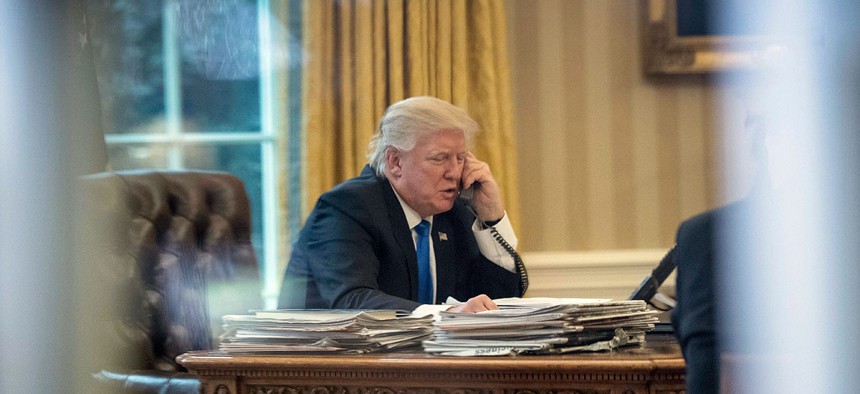
Andrew Harnik/AP file photo
An Inside Look At How Trump’s Infamous Jobs Day Tweet Roiled Some Government Economists
"The email subject lines run the gamut: "Interesting," "In case you didn't see this," "Holy moley," "Breach by POTUS," "Is it OK for us now too?"
On the morning of June 1, Donald Trump tweeted about national employment figures an hour before their release, and a number of staffers at the Bureau of Labor Statistics (BLS) weren’t pleased. The subject lines of their internal emails to each other capture their surprise and concern: “Interesting,” “Holy moley,” “ummm….,” “Breach by POTUS.” (“POTUS” is a common shorthand for “president of the United States.”)
Looking forward to seeing the employment numbers at 8:30 this morning.
— Donald J. Trump (@realDonaldTrump) June 1, 2018
Many people inside and outside of the U.S. government saw that presidential tweet as a breach in protocol. A long-standing rule (pdf) says officials in the executive branch with access to official statistics must wait an hour after publication before publicly commenting on the data. The chair of the Council of Economic Advisers (CEA) typically receives the jobs data the day before a scheduled release, and briefs the president and a select group of officials about the market-moving numbers.
Most market watchers interpreted Trump’s “looking forward” comment as a not-so-subtle hint that the numbers were going to be good. And, indeed, the data beat analysts’ expectations and markets moved higher that day.
Emails from BLS workers after Trump’s June tweet—roughly 200 of which were reviewed by Quartz—suggest the possibility of government investigations, reference apologetic White House staffers, and express frustration and concern about the impact on confidence in public markets. The emails show in stark, uncensored terms how the president’s norm-breaking behavior upends the day-to-day operations of civil servants.
“I’m guessing there won’t be any repercussions for him,” one BLS staff member wrote. “Consequences are for the little people, not bigshots with little hands,” said an economist.
“What an ass,” one staffer wrote, when sharing a Washington Post article about the tweet with a colleague.
“I don’t know why anyone tells Trump anything,” said another in a different email thread.
The emails were obtained through a Freedom of Information Act (FOIA) request that Quartz filed with the US Department of Labor. Similar emails were previously reported on by Jason Leopold of BuzzFeed News.
“RE: So now what?”
Many of the BLS emails collected by Quartz were sent by low-level civil servants, and resemble the types of messages routinely exchanged between coworkers in the private sector when management takes unpopular actions. Sent to or from a few dozen staffers, they represent only a tiny fraction of the communication among BLS’s more than 2,000 employees.
Still, those who wrote critically of the administration could face repercussions for their messages. The White House has already targeted employees at the Environmental Protection Agency, FBI, and State Department who expressed disapproval of the administration in emails and texts. While the emails are part of the public record, because the BLS senders have little power over agency operations or government at large, Quartz is not publishing their names here.
According to a spokesperson from the Office of Inspector General, the Department of Labor’s internal watchdog is currently reviewing the BLS’s policies and procedures relating to the release of economic data. “This review does not and would not involve the president,” he said in an emailed statement. “It is solely focused on BLS processes.”
William Wiatrowski, the BLS’s acting commissioner, wrote to a group of Department of Labor colleagues six hours after Trump sent the tweet, saying that employees at the CEA—members of the Trump White House staff—apologized to him for the lapse, and that those staffers were discussing ways to avoid similar situations in the future. “For example,” Wiatrowski wrote in one of the emails obtained by Quartz, they might send a “reminder of [the quiet-period] rule with each briefing.”
Wiatrowski said he spoke with Nancy Potok, the US’s chief statistician, and that Potok was going to talk “to her bosses and CEA to emphasize rules.” He noted that he had received a request from the Department of Labor’s Inspector General “regarding our procedures.”

An email sent by William Wiatrowski
Neither Wiatrowski nor his agency’s press office responded to requests for comment.
Internal strife
Frustration with the president was evident in emails between the agency’s rank-and-file workers.
Some noted that Trump seemed to be tacitly acknowledging the trustworthiness of BLS figures—in contrast to his previous statements that the figures were fake. “At least the numbers aren’t fake anymore,” one wrote.
One employee looked for a way to use the incident as a teaching moment. “There’s probably some way in which this incident could be incorporated into our annual confidentiality training” wrote a state-employed economist who contributes to a BLS program.
In the emails reviewed by Quartz, one supervisory economist was indifferent, saying, “Surprisingly, this did not impact our day at all.”
Another seemed indignant about the uproar. “Blah, blah, blah,” he wrote. “Kinda reminds me of the late 90s when the Clinton administration released the actual employment numbers Thursday evening right before the official Friday release date. People on the left need to get over it: Trump won the election and he’s the president.” A search of news articles published in the US during the Clinton administration found no mentions of the press taking notice of an early release. The economist did not respond to Quartz’s request to clarify.






